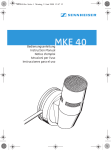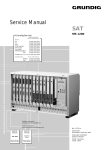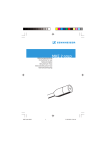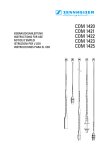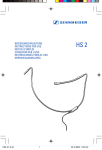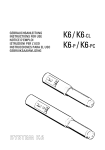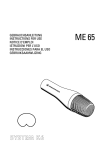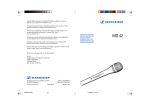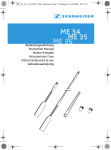Download Sennheiser Clip-on MKE 2 User's Manual
Transcript
GEBRAUCHSANLEITUNG INSTRUCTIONS FOR USE NOTICES D‘EMPLOI ISTRUZIONI PER L‘USO INSTRUCCIONES PARA EL USO GEBRUIKSAANWIJZING MKE 2 MZS 2 2 MKE 2 Kondensator-Ansteckmikrofon mit Kugelcharakteristik für höchste Ansprüche an Klangqualität und Robustheit. Geeignet für Gesang-/Sprachübertragung und Instrumentenabnahme in allen Bereichen der Liveton-Übertragungstechnik. Merkmale 앫 앫 앫 앫 Sehr kleine Abmessungen Körperschallunempfindlich Linearer Frequenzgang Robust Hinweis Wird das Mikrofon wie dargestellt oder ähnlich befestigt, ist darauf zu achten, daß 왘 das Mikrofon nicht direkt auf der Haut aufliegt, und 왘 das Mikrofon während des Schminkens abgedeckt wird, um eine Verschmutzung der Einsprache zu vermeiden. Befestigung an der Kleidung Mit der Klammer MZQ 2 befestigen Sie das Mikrofon am Revers, am Blusenkragen, an der Knopfleiste etc. Wenn es der Kleiderstoff erlaubt, können Sie das Mikrofon mit der Anstecknadel MZS 2 befestigen. Diese Befestigung ist mechanisch stark belastbar. Sie bietet sich außerdem an, wenn an der Kleidung keine Aufschläge oder Kanten sind, an denen die Klammer MZQ 2 Halt findet. Mit der Magnethalterung MZM 10 + MZM 2 haftet das Mikrofon unsichtbar auf der Kleidung. Oft reicht die Reibungskraft des Kleiderstoffes aus, daß das Mikrofon nicht verschoben wird. Bei glatten Stoffen wird von hinten zusätzlicher Halt durch die beiliegende Umhängeschnur gegeben. Lagerung des Mikrofons 왘 Mikrofon in trockenen Räumen lagern 왘 Bei Betriebsbedingungen, die stark von den im Lagerraum herrschenden klimatischen Bedingungen abweichen, Mikrofon vor Inbetriebnahme etwa 15 Minuten den geänderten klimatischen Verhältnissen aussetzen. MKE 2 - Technische Daten und Lieferumfang im Vergleich MKE 2-2R MKE 2-2R bd MKE 2-2R rd MKE 2-60 MKE 2-4 MKE 2-5 MKE 2-P Richtcharateristik Kugel Kugel Kugel Kugel Kugel Kugel Kugel Übertragungsbereich 20-20000 Hz ± 3 dB 20-20000 Hz ± 3 dB 20-20000 Hz ± 3 dB 20-20000 Hz ± 3 dB 20-20000 Hz ± 3 dB 20-20000 Hz ± 3 dB 20-20000 Hz ± 3 dB FreifeldleerlaufÜbertragungsfaktor (1kHz) 31 mV / Pa ± 2,5 dB 0,35 mV / Pa ± 2,5 dB 6,3 mV / Pa ± 2,5 dB 6,3 mV / Pa ± 2,5 dB 6,3 mV / Pa ± 2,5 dB 31 mV / Pa ± 2,5 dB 10 mV / Pa ± 2,5 dB Nennimpedanz 2700 Ω 600 Ω 1000 Ω 200 Ω 1000 Ω 2700 Ω 50 Ω Min. Abschlußimpedanz 15 KΩ 3,3 KΩ 4,7 KΩ 1000 Ω 4,7 KΩ 15 KΩ 1 KΩ Ersatzgeräuschpegel A-bewertet (DIN IEC 651) CCIR-bewertet (CCIR 468-1) 27 dB 38 dB 27 dB 38 dB 27 dB 38 dB 27 dB 38 dB 27 dB 38 dB 27 dB 38 dB 27 dB 38 dB Grenzschalldruckpegel 120 dB 150 dB 140 dB 140 dB 140 dB 120 dB 130 dB Speisung aus Sender SK 2012 aus Sender SK 2012 aus Sender SK 2012 aus K6/K6P Speisemodul aus Sender SK 50/SK 250 offenes Kabelende Phantomspeisung 12-48 V Stecker Mikrodot Mikrodot Mikrodot Sonderstecker Lemo-Stecker 4-polig System K6 - XLR-3-Stecker mit integriertem PhantomSpeiseadapter Kabellänge 1,5 m 1,5 m 1,5 m 3m 1,5 m 4m 3m Durchmesser des Mikrofons 6 mm 6 mm 6 mm 6 mm 6 mm 6 mm 6 mm Gewicht (ohne Stecker + Kabel) 1g 1g 1g 1g 1g 1g 1g 2 2 1 1 - 2 2 1 1 2 2 1 - 2 2 1 1 - 2 2 1 1 im Lieferumfang des Mikrofons: Windschutz MZW 2 Befestigungsklammer MZQ 2 Anstecknadel MZS 2 Magnethalterset MZM2/MZM10 Frequenzdiagramm Reinigen der Einsprache Einsprache entsprechend Abbildung vom Mikrofon abziehen. Das Lösen der Einsprache kann im Einzelfall mit den Fingern oder einem Werkzeug mit stumpfer Klinge erfolgen. Bei mehreren Mikrofonen und kurzen Reinigungsintervallen (z.B. 1 x wöchentlich) wird die Verwendung eines Abziehwerkzeuges (Bestell-Nr. 37990) empfohlen, das über die Sennheiser Service-Abteilung zu beziehen ist. Die Reinigungsintervalle sind vom Verschmutzungsgrad abhängig. Die Reinigung der Einsprache sollte im Ultraschallbad mit Kaltron o.ä. erfolgen. Bei sehr starker Verschmutzung oder mechanischer Beschädigung Einsprache gegen eine neue austauschen (Bestell-Nr. 26317: schwarz; 19037: beige). Zur Anwendung des Windschirms bitte vorher die Gazekappe abziehen. � � 5 MZS 2 6 MKE 2 Condensor clip-on microphone with omni-directional characteristic for top soundquality and robustness requirements. Suitable for vocal transmission and miking up instruments in all fields of live sound transmission. Characteristics 앫 앫 앫 앫 Extremely small size Insensitive to structure-borne noise Linear frequency response Robust Note If the microphone is fastened as shown or in a similar manner, it is essential to ensure that 왘 왘 it is not in direct contact with the skin it is covered up whilst make-up is applied in order to prevent contamination of the sound inlet. Attachment to articles of clothing MZQ 2: this clip serves to attach the mic to the collar, lapel or button hole etc. The pin MZS 2 can be used for rough clothing. The ZH 2 pin provides high stability. This pin is also suitable for articles of clothing which do not have a collar or lapel to attach the mic with the MZQ 2 clip. MZM 10+MZM 2: this magnetic clip is quite unobtrusive. Often the frictional force between the mic and the clothing is sufficient to guarantee that the microphone is not dislocated. In addition, the neckstrap (included) ensures that the mic cannot be displaced from its proper position, especially with regard to smooth clothes. Storing the microphone 왘 왘 The microphone should be stored in a dry room. If the operating conditions deviate substantially from the climatic conditions in the storage room, the microphone, should be exposed to the new climatic conditions for roughly 15 minutes prior to operation. MKE 2 - Technical dat in comparison MKE 2-2R MKE 2-2R bd MKE 2-2R rd MKE 2-60 MKE 2-4 MKE 2-5 MKE 2-P Directional characteristic omnidirectional omnidirectional omnidirectional omnidirectional omnidirectional omnidirectional omnidirectional Transmission range 20-20000 Hz ± 3 dB 20-20000 Hz ± 3 dB 20-20000 Hz ± 3 dB 20-20000 Hz ± 3 dB 20-20000 Hz ± 3 dB 20-20000 Hz ± 3 dB 20-20000 Hz ± 3 dB Free-field open-circuit sensitivity (1kHz) 31 mV / Pa ± 2.5 dB 0.35 mV / Pa ± 2.5 dB 6.3 mV / Pa ± 2.5 dB 6.3 mV / Pa ± 2.5 dB 6.3 mV / Pa ± 2.5 dB 31 mV / Pa ± 2.5 dB 10 mV / Pa ± 2.5 dB Rated impedance 2700 Ω 600 Ω 1000 Ω 200 Ω 1000 Ω 2700 Ω 50 Ω Min. terminating impedance 15 KΩ 3.3 KΩ 4.7 KΩ 1000 Ω 4.7 KΩ 15 KΩ 1 KΩ Equivalent noise level A-weighted (DIN IEC 651) CCIR-weighted (CCIR 468-1) 27 dB 38 dB 27 dB 38 dB 27 dB 38 dB 27 dB 38 dB 27 dB 38 dB 27 dB 38 dB 27 dB 38 dB Sound pressure level limit 120 dB 150 dB 140 dB 140 dB 140 dB 120 dB 130 dB Feed from transmitter from transmitter from transmitter from K6/K6P feed modul SK 2012 SK 2012 SK 2012 Plug Mikrodot Mikrodot Mikrodot special plug system K6 Lemo-plug 4-polig - XLR-3-plug with integrated phantom feed adapter Cable length 1.5 m 1.5 m 1.5 m 3m 1.5 m 4m 3m Diameter of the microphone 6 mm 6 mm 6 mm 6 mm 6 mm 6 mm 6 mm Weight (without plug+cable) 1g 1g 1g 1g 1g 1g 1g 2 2 1 1 - 2 2 1 1 2 2 1 - 2 2 1 1 - 2 2 1 1 from transmitter open SK 50/SK 250 cable end phantom feed 12-48 V Delivery includes: Wind-shield MZW 2 Clip MZQ 2 Pin MZS 2 Magnetic holder set MZM2/MZM10 Frequency response Cleaning the sound inlet Pull the sound inlet off of the microphone as shown. Release the inlet either with your fingers or using a tool with a blunt edge. If several microphones with short cleaning intervals (e.g. once a week) are used, it is advisable to order a specia! tool (Order No. 37 990) from your Sennheiser dealer. The cleaning intervals are dependent on the degree of contamination. An ultrasonic bath and Kaltron or similar should be used for cleaning. In the event of severe contamination or mechanical damage the sound inlet must be replaced with a new inlet (Order No. 26317: black; 19037: beige). Before attaching the windscreen, please remove the gauze cap. � � 9 MZS 2 10 MKE 2 Micro-cravate à condensateur à directivité omnidirectionnelle satisfaisant à des exigences élevées de qualité de son et de robustesse. Prévu pour la transmission vocale et instrumentale dans tous les domaines de la technique de transmission du son en direct. Ses caractéristiques 앫 앫 앫 앫 Dimensions extrêment réduites Insensible au bruit d’impact Réponse en fréquence linéaire Robuste Remarque Si le micro est fixé comme indiqué dans le schéma ou d’une manière similaire, il faut absolument veiller à ce 왘 qu’il ne soit pas en contact direct avec la peau et 왘 qu’il soit protégé pendant le maquillage afin d'éviter tout salissement de la tête. Fixation aux vêtements Fixez le micro avec la pince MZQ 2 au revers, au col, à la patte de boutonage etc. Si le tissu des vêtements le permet, vous pouvez fixer le micro avec la pince MZS 2. Ce type de fixation tient très bien. Elle est en outre recommandée quand les vêtements n‘ont pas de revers ou de parement où fixer la pince MZQ 2. Avec la fixation magnétique MZM 10/MZM 2, le micro adhère de manière invisible aux vêtements. Dans la plupart des cas, le frottement des vêtement suffit pour èviter tout déplacement du micro. Dans le cas des tissus lisses, le cordon joint au micro assure un maintien supplémentaire autour du cou. Rangement du microphone 왘 Conserver le micro dans une pièce sèche. 왘 Quand om utilise le micro dans des conditions ambiantes très différentes de celles de son lieu de rangement, le sortir environs 15 minutes avant de la mettre en service. MKE 2 - Vue synoptique des caractéristiques techniques MKE 2-2R MKE 2-2R bd MKE 2-2R rd MKE 2-60 MKE 2-4 MKE 2-5 MKE 2-P Directivité omnidirection. omnidirection. omnidirection. omnidirection. omnidirection. omnidirection. omnidirection. Bande passante 20-20000 Hz ± 3 dB 20-20000 Hz ± 3 dB 20-20000 Hz ± 3 dB 20-20000 Hz ± 3 dB 20-20000 Hz ± 3 dB 20-20000 Hz ± 3 dB 20-20000 Hz ± 3 dB Facteur de transmission en champ libre (1kHz) 31 mV / Pa ± 2,5 dB 0,35 mV / Pa ± 2,5 dB 6,3 mV / Pa ± 2,5 dB 6,3 mV / Pa ± 2,5 dB 6,3 mV / Pa ± 2,5 dB 31 mV / Pa ± 2,5 dB 10 mV / Pa ± 2,5 dB Impédance nominale 2700 Ω 600 Ω 1000 Ω 200 Ω 1000 Ω 2700 Ω 50 Ω Impédance terminale min. 15 KΩ 3,3 KΩ 4,7 KΩ 1000 Ω 4,7 KΩ 15 KΩ 1 KΩ Niveau de bruit équivalent Pondération A (DIN IEC 651) Pondération CCIR (CCIR 468-1) 27 dB 38 dB 27 dB 38 dB 27 dB 38 dB 27 dB 38 dB 27 dB 38 dB 27 dB 38 dB 27 dB 38 dB Niveau de pression acoustique limite 140 dB 120 dB 130 dB câble sans fiche alimentation fantôme 12-48 V 120 dB 150 dB 140 dB 140 dB Alimentation par l‘émetteur SK 2012 par l‘émetteur SK 2012 par l‘émetteur SK 2012 par l‘émetteur par le modul d‘aliment.K6/K6P SK 50/SK 250 Fiche Mikrodot Mikrodot Mikrodot fiche spéciale système K6 fiche Lemo 4 pôles - fiche XLR-3 avec adapteur d‘alimentation fantôme intégré Longueur du câble 1,5 m 1,5 m 1,5 m 3m 1,5 m 4m 3m Diamètre du micro 6 mm 6 mm 6 mm 6 mm 6 mm 6 mm 6 mm Poids (sans fiche ni câble) 1g 1g 1g 1g 1g 1g 1g 2 2 1 1 - 2 2 1 1 2 2 1 - 2 2 1 1 - 2 2 1 1 Accessoires Capuchon paravent MZW 2 Pince de fixation MZQ 2 Epingle de fixation MZS 2 Fixation magnétique MZM2/MZM10 Réponse en fréquence Nettoyage de la tête du micro Retirer la tête du micro comme sur le croquis. Il est possible de détacher la tête avec les doigts ou avec un outil à pointe émoussée. Quand on dispose de plusieurs micros et que les intervalles de nettoyage sont fréquents (p.ex. une fois par semaine), il est recommandé d‘utiliser un extracteur (référence 37990) que vous pouvez vous procurer auprès de votre distributeur Sennheiser. La fréquence de nettoyage est fonction du degré de salissure. La tête doit être nettoyée dans uns bain à ultrasons, acec du Kaltron p.ex. Remplacer la tête du micro par une neuve (référence 26317: noire; 19037: beige) lorsqu‘elle est très sale ou détériorée. Pour utiliser la boule antivent, prière de retirer auparavant le capuchon de gaze. � � 13 MZS 2 14 MKE 2 Microfono con clip munito di condensatore con caratteristica omnidirezionale per elevate esigenze di qualità di suono e robustezza. Adatto per la trasmissione vocale e strumentale in tutti i campi della tecnica di trasmissione del suono in diretta. Le sue caratteristiche 앫 앫 앫 앫 Dimensioni estremamente ridotte Insensibilità alle vibrazioni Risposta armonica lineare Robustezza Avvertenza Se il microfono viene fissato come indicato nella figura B.3 o in una maniera simile, fare assolutamente attenzione a quanto segue: 왘 왘 il microfono non deve essere a diretto contatto con la pelle: il microfono deve essere protetto durante il trucco per evitare che dello sporco penetri nella testina del microfono. Fissaggio ai vestiti Con la graffa MZQ 2 fissate il microfono al risvolto, al colletto della camicia, all’abbottonatura ecc. Se la stoffa del vestito lo permette potete fissare il microfono con lo spillo per appuntare MZS 2. Questo fissaggio permette elevate sollecitazioni meccaniche. Questo fissaggio è inoltre consigliabile quando i vestiti non presentano risvolti o bordi a cui poter fissare la graffa MZQ 2. Con il supporto magnetico MZM 10/MZM 2 il microfono aderisce in modo invisibile ai vestiti. Spesso è sufficiente la forza di attrito della stoffa dei vestiti per evitare lo spostamento dei microfoni. Per stoffe lisce viene utilizzato il supporto supplementare dal lato posteriore attraverso l’acclusa corda di attacco. Conservazione del microfono 왘 왘 Conservare il microfono in un locale asciutto. Se il microfono viene utilizzato in un ambiente climatico completamente diverso da quello del lluogo di conservazione, prima della messa in funzione, esporre il microfono per circa 15 minuti alle condizioni climatiche modificate. MKE 2 - Dati tecnici in confronto 20-20000 Hz ± 3 dB 10 mV / Pa ± 2,5 dB 20-20000 Hz ± 3 dB omnidirezionale omnidirezionale omnidirezionale omnidirezionale omnidirezionale omnidirezionale omnidirezionale MKE 2-P 20-20000 Hz ± 3 dB 31 mV / Pa ± 2,5 dB MKE 2-5 20-20000 Hz ± 3 dB 6,3 mV / Pa ± 2,5 dB MKE 2-4 20-20000 Hz ± 3 dB 6,3 mV / Pa ± 2,5 dB MKE 2-60 20-20000 Hz ± 3 dB 6,3 mV / Pa ± 2,5 dB MKE 2-2R rd Caratteristica di direttività 20-20000 Hz ± 3 dB 0,35 mV / Pa ± 2,5 dB MKE 2-2R bd Band di trasmissione 31 mV / Pa ± 2,5 dB 1 KΩ 50 Ω MKE 2-2R Risposta sensibilità nel campo libero (1kHz) 15 KΩ 27 dB 38 dB 2700 Ω 130 dB 4,7 KΩ 27 dB 38 dB 1000 Ω 120 dB 1000 Ω 27 dB 38 dB 200 Ω 140 dB 4,7 KΩ 27 dB 38 dB 1000 Ω 140 dB 3,3 KΩ 27 dB 38 dB 600 Ω 140 dB 15 KΩ 27 dB 38 dB 2700 Ω 150 dB Min. impedenza terminale 120 dB 27 dB 38 dB Impedenza nominale Livello di pressione sonora limite Spina XLR-3 con adattatore integrato alimentazione virtuale Livello del rumore equivalente Valutazione A (DIN IEC 651) Valutazione CCCIR (CCIR 468-1) - 3m Alimentazione virtuale 12-48 V Spina Lemo a 4 poli 4m da trasmettitore Estremità SK 50/SK 250 libera cavo Spina speziale sistema K6 1,5 m Alimentazione Mikrodot 3m 1g 6 mm da trasmettitore da trasmettitore da trasmettitore da modulo alimentazione SK 2012 SK 2012 SK 2012 K6/K6P 1,5 m 1g 6 mm Mikrodot 1,5 m 1g 6 mm Mikrodot 1,5 m 1g 6 mm Spina Lunghezza cazo 1g 2 2 1 1 6 mm - 1g 2 2 1 1 6 mm 2 2 1 - 1g 2 2 1 1 6 mm - Diametro del microfono Volume di fornitura 2 2 1 1 Peso (senza spina + cavo) Cuffia antivento MZW 2 Supporto di fissaggio MZQ 2 Supporto per appuntare MZS 2 Set supporti magnet. MZM2/MZM10 Risposta in frequenza Pulizia della testina del microfono Sfilare dal microfono la testina sulla base della figura. La testina si può staccare manualmente o con l’aiuto di un attrezo non appuntito. In caso di pulizia di più microfoni e intervalli di pulizia brevi (ad esempio 1 volta la settimana) si consiglia di utilizzare un estrattore (n. di ordinazione 37 990), che si può acquistare tramite il suo distributore Sennheiser. Gli intervalli di pulizia dipendono dal grado di sporco. La pulizia dovrebbe essere effettuata in bagno ad ultrasuoni con Kaltron o prodotti simili. In caso di sporco tenace o danni meccanici, è necessario sostituire la testina con una nuova (n. di ordinazione 26317: nera; 19037: color beige). Per l'impiego del paravento sfilare prima il cappuccio di garza. � � 17 MZS 2 18 MKE 2 Micrófono de condensador de solapa con característica omnidireccional para satisfacer las máximas exigencias en cuanta a calidad de sonido y robustez. Apropiado para transmisión vocal, de canto e instrumental en todos los campos de la transmisión de sonido en directo. Sus caracteristicas 앫 앫 앫 앫 Dimensiones muy reducidas Insensible al sonido corporal Respuesta de frecuencia lineal Robusto Nota Si el micrófono se sujeta tal como se muestra en B. 3 o de modo similar, deberá atenderse imprescindiblemente a que 왘 왘 el micrófono no esté en contacto directo con la piel, y el micrófono se cubra durante el maquillaje para que no se ensucie su pantalla. Modo de fijar el micrófono a las prendas de vestir Utilizando el clip MZQ 2 podrá Vd. fijar el micrófono a la solapa, al cuello de la blusa, a la abotonadura, etc. Según la calidad del material de la prenda de vestir el micrófono podrá sujetarse con el alfiler especial MZS 2. Desde el punto de vista mecánico, este tipo de fijación es más resistente a los esfuerzos mecánicos. Este tipo de fijación también resulta apropiado para usarlo en prendas de vestir que carecen de guarniciones o bordes a los cuales pueda sujetarse firmemente el clip MZQ 2. El soporte magnético MZM 10/MZM 2 permite fijar el micrófono oculto en las prendas de vestir. Con frecuencia, la fuerza de frotamiento de las prendas es suficiente para impedir que el micrófono se desplace. No obstante, en caso de materiales lisos puede lograrse mayor resistencia por el revés de las prendas, utilizando el cordón incluido en el suministro. Almacenaje del micrófono 왘 왘 Almacenar el micrófono en recintos secos. En el caso de utilizar el micrófono en condiciones climáticas que difieran mucho de las que imperan en el almacén, exponer el micrófono a las nuevas condiciones climáticas durante unos 15 minutos antes de ponerlo en funcionamiento. Reserva de modificaciones MKE 2 - Comparación de datos técnicos MKE 2-2R MKE 2-2R bd MKE 2-2R rd MKE 2-60 MKE 2-4 MKE 2-5 MKE 2-P Caraterística direcional Esfera Esfera Esfera Esfera Esfera Esfera Esfera Gama de transmisión 20-20000 Hz ± 3 dB 20-20000 Hz ± 3 dB 20-20000 Hz ± 3 dB 20-20000 Hz ± 3 dB 20-20000 Hz ± 3 dB 20-20000 Hz ± 3 dB 20-20000 Hz ± 3 dB Factor de transmisión de campo libre en vacío (1kHz) 31 mV / Pa ± 2,5 dB 0,35 mV / Pa ± 2,5 dB 6,3 mV / Pa ± 2,5 dB 6,3 mV / Pa ± 2,5 dB 6,3 mV / Pa ± 2,5 dB 31 mV / Pa ± 2,5 dB 10 mV / Pa ± 2,5 dB Impedancia nominal 2700 Ω 600 Ω 1000 Ω 200 Ω 1000 Ω 2700 Ω 50 Ω Impedancia final mínima 15 KΩ 3,3 KΩ 4,7 KΩ 1000 Ω 4,7 KΩ 15 KΩ 1 KΩ Nivel de ruidos equivalente Evaluación A (DIN IEC 651) Evaluación CCIR (CCIR 468-1) 27 dB 38 dB 27 dB 38 dB 27 dB 38 dB 27 dB 38 dB 27 dB 38 dB 27 dB 38 dB 27 dB 38 dB 140 dB Nivel límite de presión sonora 120 dB 150 dB 140 dB 140 dB 120 dB 130 dB Alimentación tomada del transmisor SK 2012 tomada del transmisor SK 2012 tomada del transmisor SK 2012 tomada del tomada del módulo de alim. transmisor K6 / K6P SK 50/SK 250 extrema del cable abierto Alimentación de fantomización 12-48 V Enchufe Mikrodot Mikrodot Mikrodot enchufe especial Sistema K6 enchufe LEMO de cuatro polos - enchufe XLR-3 con adaptador integrado de alimentación fantomizada 3m Largo del cable 1,5 m 1,5 m 1,5 m 3m 1,5 m 4m Diámetro del micró 6 mm 6 mm 6 mm 6 mm 6 mm 6 mm 6 mm Peso (sin enchufe ni cable) 1g 1g 1g 1g 1g 1g 1g 2 2 1 1 - 2 2 1 1 2 2 1 - 2 2 1 1 - 2 2 1 1 El suministro incluye Caperuza antiviento MZW 2 Clip MZQ 2 Alfiler MZS 2 Juego de soporte magn. MZM2/10 Respuesta en frecuencia Limpieza de la pantalla Separar la pantalla del microfono tal como muestra la figura. Para casos aislados, la pantalla puede soltarse con los dedos o utilizando una herramienta de punta abtso. En el caso de varios micrófonos e intervalos de limpieza cortos (p. ej. una vez por semana), se recomienda utilizar una herramienta extractora (ref. 37990) que puede adquirirse a través de su distribuidor Sennheiser. Los intervalos de limpieza dependen del grado de suciedad. La limpieza debe realizarse en baño de ultrasonidos con Kaltron u otro producto similar. En caso de gran suciedad o de daños mecánicos, la pantalla deberá cambiarse por una nueva (ref. 26317: negra; 19037: color beige). Para utilizar la pantalla antiviento retirar antes la caperuza de gasa. � � 21 MZS 2 22 MKE 2 Condensator-aansteekmicrofoon met kogelkarakteristiek voor de hoogste eisen aan klankkwaliteit en robuustheid. Geschikt voor gezang/spraakoverdracht en instrumentenafname in alle bereiken van de overdrachttechniek van livegeluid. Kenmerken 앫 앫 앫 앫 Zeer kleine afmetingen Ongevoelig voor lichaamsakoestiek Lineaire frequentiekarakteristiek Robuust Opmerking Wanneer de microfoon net als op de afbeelding wordt bevestigd dient erop te wordne gelet, dat 왘 왘 de microfoon niet direct op de huid ligt en de microfoon tijdens het schminken wordt afgeschernmd om een verontreiniging van de inspreekkop te vermijden Bevestiging aan de kleding Met de klem MZQ 2 bevestigt u de microfoon aan de revers, aan de kraag van een bloes, aan de knopenboord enz. Wanneer de stof van de kleding dit toelaat, kunt u de microfoon met de speld MZS 2 bevestigen. Deze bevestiging is mechanisch zwaar belastbaar. Deze bevestiging is bovendien geschikt wanneer de kleding geen omslagen of randen heeft waaraan de klem MZQ 2 houvast heeft. Met de magneethouder MZM 10 + MZM 2 hecht de microfoon onzichtbaar op de kleding. Vaak is de wrijfkracht van de stof voldoende om de microfoon op zijn plaats blijft.. Bij gladde stoffen wordt aand e achterzijde extra houvast geboden door het ingesloten omhangsnoer. Bewaren van de microfoon 왘 왘 Microfoon in droge ruimten bewaren Bij weersomstandigheden, die sterk afwijken van het klimaat dat in de opslagruimte geldt, dient u de microfoon voor de inwerkingsstelling ongeveer 15 minuten bloot te stellen aan de veranderde weersomstandigheden. MKE 2 - Vergelijk van de technische gegevens en de leveromvang MKE 2-2R MKE 2-2R bd MKE 2-2R rd MKE 2-60 MKE 2-4 MKE 2-5 MKE 2-P Richtkarakteristiek Kogel Kogel Kogel Kogel Kogel Kogel Kogel Frequentieweergave 20-2000 Hz +/- 3 dB 20-20000 Hz +/- 3 dB 20-20000 Hz +/- 3 dB 20-20000 Hz +/- 3 dB 20-20000Hz +/- 3 dB 20-20000 Hz +/- 3 dB 20-20000 Hz +/- 3 dB Onbelaste werking frequentiefaktor veld (1 kHz) 31 mV/Pa +/- 2,5 dB 0,35 mV/Pa +/- 2,5 dB 6,3 mV/Pa +/- 2,5 dB 6,3 mV/Pa +/- 2,5 dB 6,3 mV/Pa +/- 2,5 dB 31 mV/Pa +/- 2,5 dB 10 mV/Pa +/- 2,5 dB Nominale impedantie 2700 Ω 600 Ω 1000 Ω 200 Ω 1000 Ω 2700 Ω 50 Ω Min. afsluitimpedantie 15 KΩ 3,3 KΩ 4,7 KΩ 1000 KΩ 4,7 KΩ 15 KΩ 1 KΩ Geluidsdrukniveau A-waarde (DIN IEC 651) CCIR-waarde (CCIR 468-1) 27 dB 38 dB 27 dB 38 dB 27 dB 38 dB 27 dB 38 dB 27 dB 38 dB 27 dB 38 dB 27 dB 38 dB Max. geluidsdrukniveau 120 dB 150 dB 140 dB 40 dB 140 dB 120 dB 130 dB Voeding uit zender SK 2012 uit zender SK 2012 uit zender SK 2012 uit K6/K6P voedingsmoduul uit zender SK 50/ SK 250 open kabeleinde fantoomvoeding 12-48 V Stekker Microdot Microdot Microdot Speciale stekker systeem K6 Lemostekker 4-polig Kabellengte 1,5 m 1,5 m 1,5 m 3m 1,5 m 4m 3m Diameter v.d. microfoon 6 mm 6 mm 6 mm 6 mm 6 mm 6 mm 6 mm Gewicht (zonder stekker + kabel) 1g 1g 1g 1g 1g 1g 1g 2 2 1 1 - 2 2 1 1 2 2 1 - 2 2 1 1 - 2 2 1 1 XLR-stekker met geïntegreerde fantoom-voedings adapter In leveromvang van microfoon: Windbescherming MZW 2 Bevestigingsklem MZQ 2 Aansteekspeld MZS 2 Magneethouderset MZM 2/MZM 10 Frequentiediagram Reinigen van de inspreekkop Inspreekkop volgens de afbeelding van de microfoon trekken. Het losmaken van de inspreekkop kan in sommige gevallen met de vingers of een gereenschap met stomp lemmet wordne uitgevoerd. Bij meerdere microfoons en korte reinigingsintervallen (bijv. 1 x per week) wordt de toepassing van een aftrekgereedschap (bestelnummer 37990) aanbevolen, dat u via de Sennheiser Service Afdeling kunt bestellen. De reinigingsintervallen zijn afhankelijk van de graad van de verontreiniging. De reiniging van de inspreekkop dient in een ultrasonoor bad met kaltron o.i.d plaats te vinden. Bij zeer sterke verontreiniging of mechanische beschadiging inspreekkop door een nieuwe vervangen (bestelnummer 26317: zwart; 19037: beige). Voor de toepassing van het windscherm a.u.b. eerst de gazen kap verwijderen. � � 25 Änderungen vorbehalten Subject to alterations Sous réserve de modifications Con riserva di modifiche Reservado el derecho a introducir modificaciones Wijzigingen voorbehouden Sennheiser electronic KG Telefon: 05130/600-0 Telefax: 05130/6312 D-30900 Wedemark Printed in Germany Publ. 8/95 18273 / A11
This document in other languages
- français: Sennheiser Clip-on MKE 2
- español: Sennheiser Clip-on MKE 2
- Deutsch: Sennheiser Clip-on MKE 2
- Nederlands: Sennheiser Clip-on MKE 2
- italiano: Sennheiser Clip-on MKE 2


























